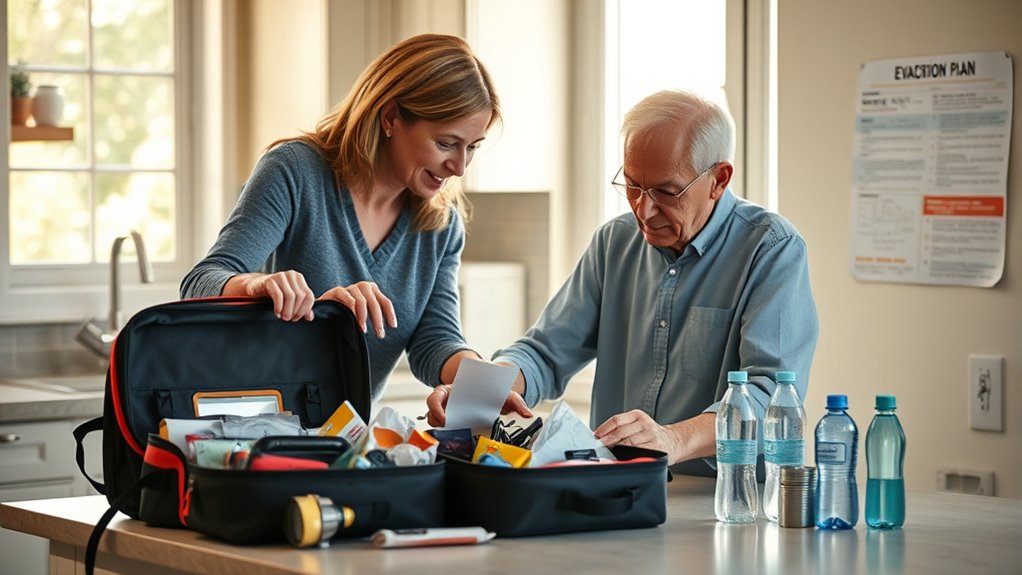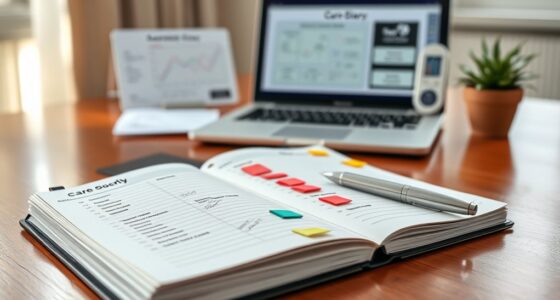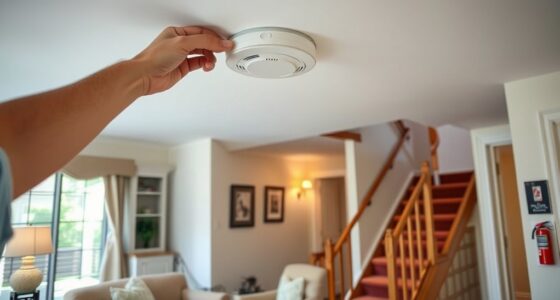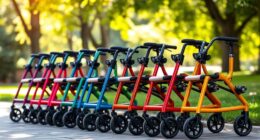To prepare for emergencies, understand your area’s risks like floods or earthquakes and learn local protocols such as evacuation routes and community drills. Create a detailed plan with clear communication strategies and practiced procedures. Pack essential supplies, including medications and medical devices, in an accessible kit. Stay informed through alerts and community updates, and regularly review your plan to adapt to changing conditions. Keep exploring to discover more ways to guarantee safety and confidence during crises.
Key Takeaways
- Understand local disaster risks, community protocols, and participate in emergency drills to ensure informed response strategies.
- Develop, practice, and regularly update a comprehensive emergency plan including evacuation routes and communication methods.
- Prepare and maintain an accessible emergency kit with necessary medications, supplies, and assistive devices for at least 3-7 days.
- Designate and practice communication with emergency contacts outside the affected area, using multiple channels for redundancy.
- Stay informed through real-time alerts, community training, and adapt plans based on evolving local conditions and risks.
Recognizing Disaster Risks in Your Area
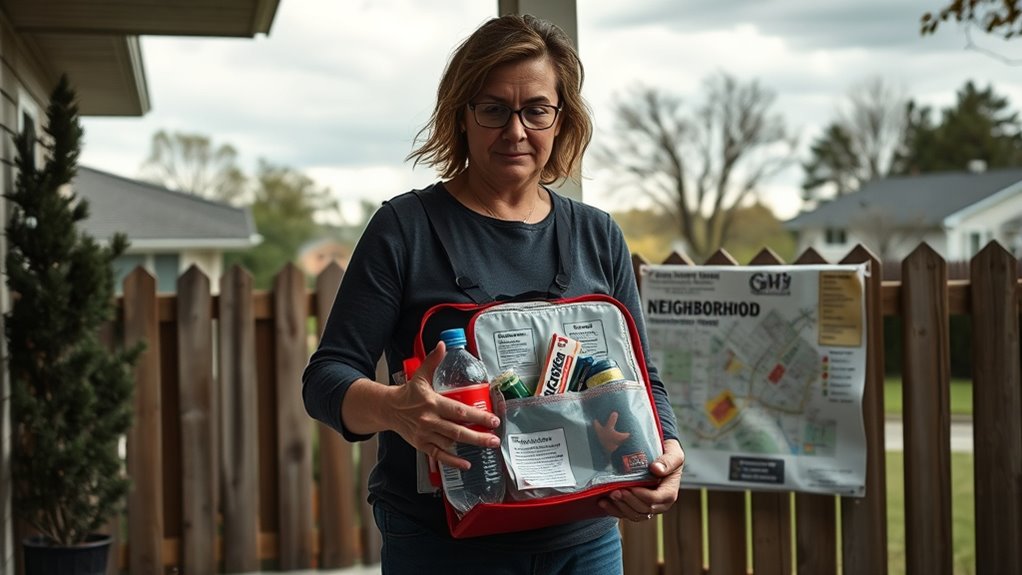
How well do you know the natural risks in your community? Recognizing disaster risks is essential for effective emergency preparations. Start by reviewing local hazard maps and government reports to understand specific threats like earthquakes, floods, hurricanes, or wildfires.
Knowing which disasters are most likely helps you prioritize your planning and resources. Pay attention to seasonal patterns, such as hurricane season or wildfire risk periods, so you can prepare in advance.
Familiarize yourself with local emergency alerts and evacuation zones to guarantee swift action when needed. Understanding the historical frequency and severity of disasters in your area empowers you to make informed decisions.
Being aware of these risks allows you to stay prepared and respond confidently when disaster strikes.
Building a Comprehensive Emergency Plan
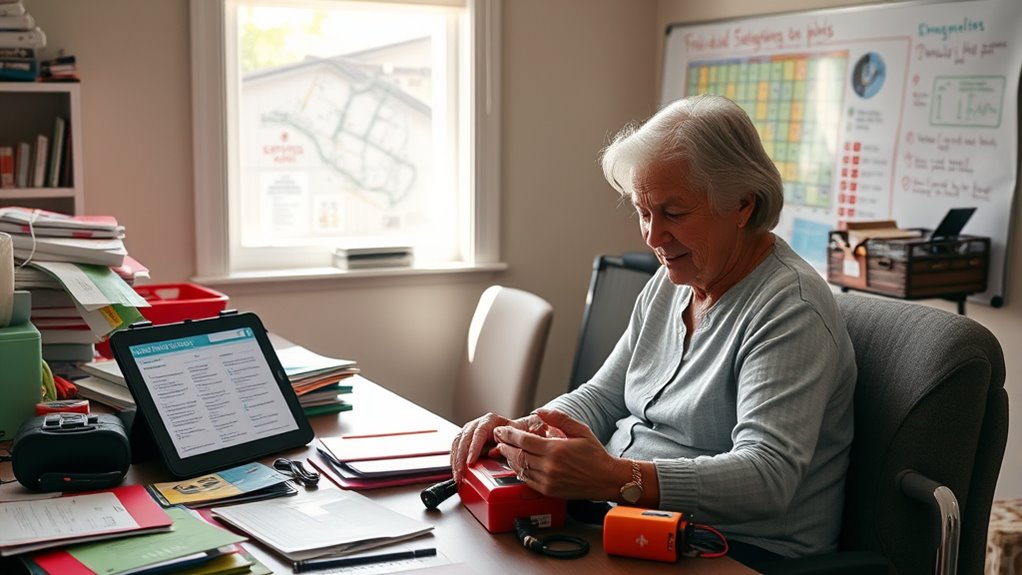
Creating a thorough emergency plan means identifying multiple evacuation routes suited for your home and community.
Make sure to establish clear communication strategies, including an emergency contact outside your area, and share these plans with everyone involved.
Regularly review and update your plan to keep it effective and relevant.
Evacuation Routes and Plans
Having a well-planned evacuation route is essential for ensuring safety during emergencies. Your evacuation plan should include multiple emergency routes, giving you options if one is blocked or unsafe. Familiarize yourself with local evacuation routes and transportation options in advance, so you can act quickly when needed. Coordinate your evacuation procedures with healthcare providers, family, and neighbors to ensure everyone responds cohesively. Practice accessing emergency supplies and medical equipment swiftly, reducing confusion in a crisis. Regularly review and update your evacuation plan to reflect changes in your environment or your care recipient’s needs. Here’s a quick overview:
| Emergency Route | Key Considerations |
|---|---|
| Main Route | Fastest, most familiar |
| Alternative Route | Less congested, safe backup |
| Transportation | Public, private options |
| Emergency Supplies | Ready access, organized |
Contact and Communication Strategies
Establishing clear contact and communication strategies is essential for responding effectively during emergencies. You should designate an emergency contact outside your area and ensure your family and neighbors know how to reach this person.
Keep an updated list of emergency contacts, including healthcare providers and emergency services, so everyone has quick access to crucial information. To enhance your communication plan, consider incorporating high refresh rates to ensure timely responses during emergencies. Additionally, it is important to understand that privacy policies guide how personal information is shared and protected, which can be crucial during emergencies. Implementing robust fraud detection measures can help protect sensitive information when communicating during crises. During these times, having a clear understanding of legal implications can also aid in swift decision-making.
Develop a communication plan that outlines how to reach each other during power outages, natural disasters, or other crises. Use multiple channels like cell phones, landlines, and text messages to stay connected.
Regularly review and practice your communication plan to confirm everyone understands their roles and can access emergency contacts easily. These steps will strengthen caregiver coordination and ensure timely, coordinated responses in emergencies. Additionally, be mindful of user consent in your communication strategies, especially when using digital tools that may involve sharing personal information.
Assembling and Managing Essential Supplies
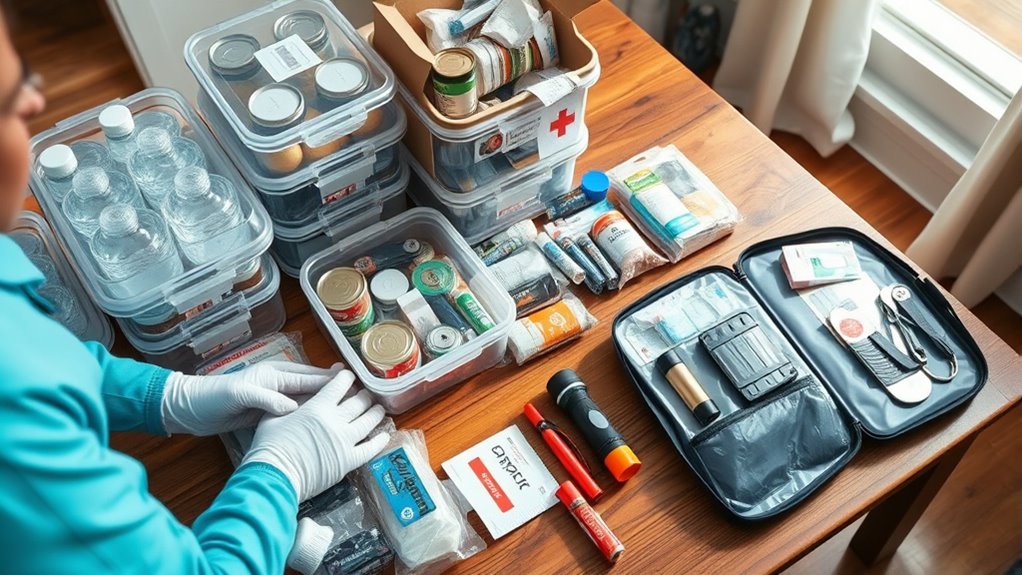
To guarantee you’re prepared for emergencies, assemble a well-organized kit with all essential supplies readily accessible. Your emergency kit should include medications, medical supplies, and assistive devices needed to last at least three to seven days. Engaging in mindfulness practices can help you remain calm and focused during emergencies, enhancing your ability to respond effectively. Additionally, being aware of electric power generation can provide alternative energy solutions during power outages.
Including a variety of non-perishable food items ensures that your dietary needs are met during an emergency.
Stock non-perishable food, water (one gallon per person per day), and basic cooking supplies for sustenance. Implementing data-driven decision-making can help ensure that your kit is tailored to meet specific needs effectively.
Organize medical equipment like oxygen tanks, mobility aids, and incontinence supplies in an accessible, designated spot so you can grab them quickly.
Regularly check expiration dates on medications and supplies, and replenish items as needed to ensure everything is current and ready. Keep a portable, clearly labeled emergency kit nearby, so you can evacuate or respond to sudden disasters without delay. Additionally, consider the importance of seasonal hours for parks or events, which can affect your emergency planning during holidays or peak times.
Proper management guarantees you’re always prepared for any emergency.
Establishing Communication and Contact Strategies

Creating a reliable communication plan is essential for guaranteeing everyone stays connected during emergencies. Start by designating an emergency contact outside your area and sharing their information with all family members and caregivers. Keep a list of updated phone numbers for healthcare providers, neighbors, emergency services, and family members to enable quick communication. Understanding city dynamics can also help caregivers anticipate challenges during emergencies. Additionally, having a wall organization system in place can help keep important documents and contact lists easily accessible during a crisis.
Establish multiple communication methods, such as phone calls, texts, emails, or emergency alert apps, in case power or internet go down. Regularly practice and review your communication plan to guarantee everyone understands their roles and knows how to reach each other. Including seasonal recommendations for communication tools can ensure that your plan remains effective throughout the year. Strong communication skills are essential in ensuring clarity and coordination among caregivers during a crisis.
Using tools like the “Where to Find My Important Papers” checklist helps keep critical contact information organized and accessible. Effective caregiver coordination depends on a solid, well-practiced communication strategy. Understanding data usage is also vital to ensure privacy during emergencies.
Understanding Community and Facility Preparedness
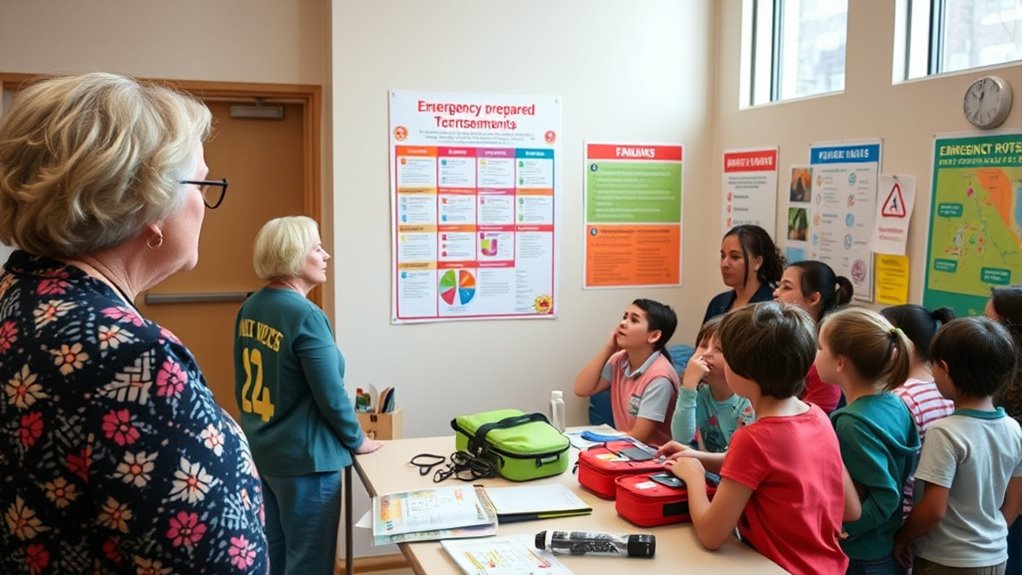
Knowing your community’s emergency protocols and senior living facility plans helps you respond quickly and confidently during disasters. Make certain you’re familiar with shelter locations and transportation options for those with mobility challenges. Staying informed through communication channels with staff and neighbors ensures everyone’s safety when it counts. Additionally, understanding emergency protocols can significantly improve response effectiveness during critical situations. Familiarizing yourself with credit card terms can also aid in managing expenses related to emergency preparedness. Having knowledge about juice yield from citrus fruits can be beneficial, especially for caregivers preparing nutritious meals during emergencies. During such times, incorporating nutrient-rich ingredients can enhance the health benefits of meals provided to those in your care. Furthermore, being aware of key steps in the divorce process can help caregivers manage legal and financial matters that may arise during emergencies.
Local Emergency Protocols
Are you familiar with the emergency protocols and procedures of your local senior living communities and healthcare providers? Knowing the local emergency protocols helps you prepare your caregiver plan effectively.
Contact your local emergency management agencies to learn about community disaster response plans and shelter locations. Additionally, ensure your emergency kit includes cold-pressed vegetable juice for its high nutrient retention, which can support health during stressful situations. Many health-conscious consumers prefer no-sugar-added brands for hydration options during emergencies. Having a reliable sound recording technique can help you capture important communications during a crisis. In addition, familiarize yourself with local disaster response plans to gain a better understanding of how your community prepares for emergencies.
Participating in community emergency drills will give you insight into what to expect and how to act during a crisis.
Review posted evacuation routes and shelter information provided by local authorities or facility staff, and ensure your plan aligns with these protocols.
Keep your contact information for community resources updated.
Understanding and following these local emergency protocols ensures you’re ready to respond swiftly, helping protect your loved one during any disaster or emergency situation. Additionally, being aware of essential oils for toothache relief can provide natural support for your loved one’s comfort in case of stress during emergencies.
Senior Community Plans
Understanding your senior community’s emergency plans is essential for ensuring your loved one’s safety during a crisis. Senior communities have specific emergency plans that include evacuation procedures, shelter locations, and communication protocols designed for residents’ needs.
Familiarizing yourself with these plans allows you to respond quickly and effectively during disasters. Many senior communities conduct regular drills and staff training to prepare residents for various emergency scenarios.
It’s important to know where the designated safe areas are and how they manage residents with mobility or medical needs during emergencies. Staying informed about your community’s emergency policies helps you coordinate care and implement safety measures smoothly.
Being proactive in understanding these plans ensures you’re ready to support your loved one when it matters most.
Healthcare Facility Procedures
Familiarizing yourself with your healthcare facility’s emergency protocols and evacuation procedures is essential for ensuring your loved one’s safety during a crisis. Knowing how to access and follow the disaster response plans helps you act quickly during medical emergencies. Confirm that your healthcare provider has updated emergency contact information and care plans. Learn the locations of emergency exits, shelter-in-place zones, and medical supply storage. Participating in facility-led emergency drills gives you firsthand experience of their disaster response.
| Emergency Protocols | Evacuation Procedures |
|---|---|
| Disaster response plans in place | Clear routes to exits |
| Staff training and drills | Designated shelter-in-place zones |
| Emergency contacts maintained | Medical supply locations |
| Communication systems tested | Practice evacuation routines |
| Updated safety policies | Coordinated response efforts |
Practicing Emergency Procedures Regularly

Practicing emergency procedures regularly is essential to guarantee you and your care recipient are prepared for unexpected situations. Conduct emergency drills and simulation exercises at least twice a year to ensure everyone knows evacuation routes and procedures.
Use checklists to identify gaps in your response plan and improve readiness. These drills help reinforce emergency procedures and build confidence, making responses quicker and more effective during actual emergencies.
Involve healthcare providers and emergency contacts in your practice sessions to coordinate support and communication strategies.
After each drill, review and update your emergency plan and supplies to address any issues uncovered. Consistent practice keeps your preparedness current, minimizes confusion, and assures you’re ready to act swiftly when emergencies happen.
Staying Informed and Adapting to New Challenges
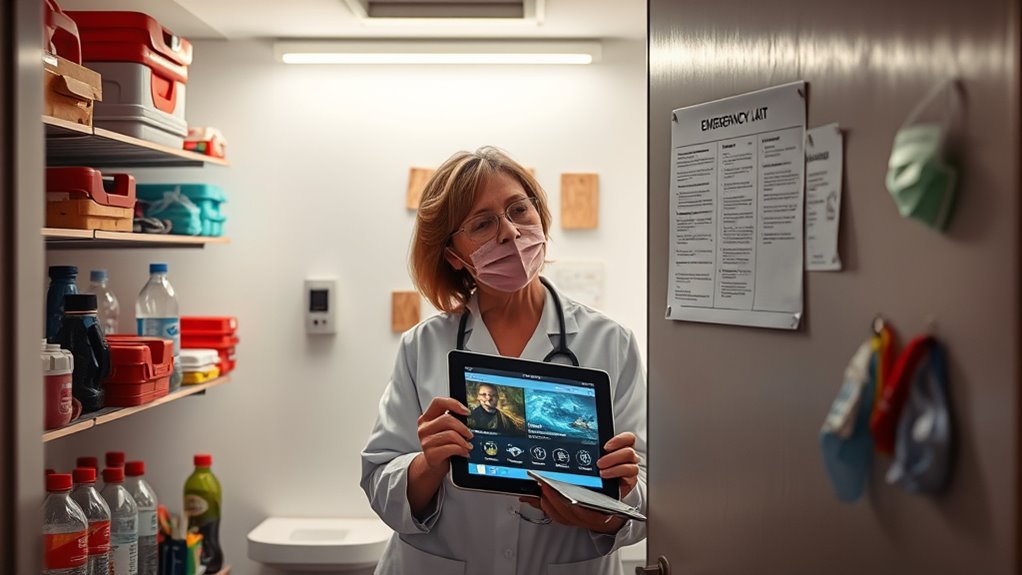
Staying informed and adapting to new challenges is crucial for effective emergency preparedness, especially as risks evolve over time. You should regularly update your knowledge of local disaster risks and response protocols to stay ready for emerging threats. Sign up for emergency alerts and news notifications to get real-time updates about hazards in your area. Review and revise your emergency plan periodically, considering recent weather patterns or infrastructure changes. Use trusted resources like FEMA and local agencies to access current guidelines and adjust your strategies accordingly. Engage in community drills and training sessions to stay current on response protocols and best practices.
| Disaster Risks | Response Protocols |
|---|---|
| New weather patterns | Updated safety procedures |
| Infrastructure changes | Evacuation plans |
| Local hazards | Communication plans |
| Community drills | First aid techniques |
Frequently Asked Questions
What Are the 5 Steps of Emergency Preparedness?
You start by understanding the risks in your area so you can plan effectively.
Then, create a clear emergency plan that includes evacuation routes and contacts.
Gather essential supplies like medications and food, making sure you’re prepared for any situation.
Establish a reliable communication method to stay connected.
Finally, practice your plan regularly and update it to stay confident and ready for emergencies.
What Is the First Thing You Should Do in an Emergency Situation as a Caregiver?
Did you know that over 80% of emergency-related injuries happen due to unpreparedness?
As a caregiver, the first thing you should do in an emergency is assess your safety immediately. Make certain there’s no ongoing danger before helping others. Your safety comes first, so quickly evaluate the scene, then call emergency services, and follow your plan.
Staying calm and acting swiftly can make all the difference.
What Are 10 Items in an Emergency Preparedness Kit?
A well-stocked emergency preparedness kit should include ten essential items. You’ll want enough water for at least three days, non-perishable food, a reliable flashlight with extra batteries, and a first aid kit.
Don’t forget necessary medications, personal hygiene supplies like moist towelettes, and important documents stored waterproof.
Add a multi-tool, a whistle for signaling, and a portable phone charger to guarantee you’re ready for any situation.
What Are the Examples of Emergency Preparedness?
You can prepare for emergencies by creating a detailed evacuation plan and knowing where local shelters are. Stockpile essential supplies like medications, food, and water. Keep your contact information updated and assign an out-of-area emergency contact.
Practice emergency drills regularly and review disaster response plans. Also, familiarize yourself with local protocols and transportation options, so you’re ready to act quickly and stay safe when disaster strikes.
Conclusion
By staying alert and prepared, you create a safety net that catches your loved ones when disaster strikes. Imagine the calm confidence in your eyes as you navigate stormy skies, knowing your plans and supplies are ready. With each drill and update, you strengthen your family’s resilience, turning chaos into control. Keep your senses sharp, stay informed, and let your proactive steps be the guiding light through any emergency that comes your way.
